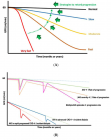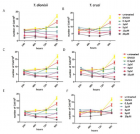Abstract
Research Article
Postgraduate students’ perception of the educational environment of a wet lab training in Neurological Surgery Division, UCH, Ibadan
Malomo Adefolarin O*, Kafayat Bolaji Aminu, Adeolu Augustine A, Adeleye Amos O, Balogun James A, Badejo Oluwakemi A, Shokunbi Mathew T and Jegede Ayodele S
Published: 12 December, 2019 | Volume 3 - Issue 1 | Pages: 064-069
Objective: The importance of understanding the perceptions of medical students to their training environment cannot be overemphasized. The study evaluated the wet lab training organized for Senior Registrars in the Neurosurgery, Division of the University College Hospital, Ibadan.
Aim: The purpose of this study is to assess the experiences of postgraduate students during wet-lab training with the aim of improving the course content and introducing evidence-based and student-centered changes.
Methodology: The study made use of a cross-sectional design and data were collected using the qualitative research approach. Information was elicited from all the Senior Registrars who participated in the training through in-depth interviews.
Result: All the postgraduate students who participated in the training were satisfied with the course content and the method of delivery appropriated during the training. They also found it relevant to their practice. However, certain shortcomings were observed such as high cost of training, poor standard of equipment/tools, tight work schedule and short training duration.
Conclusion: Hands-on training plays an important role in enhancing the quality of care and high performance in health-care service delivery. The shortcomings and suggestions for improving future trainings as reported by the residents should be addressed in order to maximize the gains of the hands-on training experience
Read Full Article HTML DOI: 10.29328/journal.cjncp.1001020 Cite this Article Read Full Article PDF
Keywords:
Wet lab training; Neurosurgery; University College Hospital; Medical education; Training environment
References
- Al-Kabbaa AF, Ahmad HH, Saeed AA, Abdalla AM, Mustafa AM. Perception of the learning environment by students in a new medical school in Saudi Arabia: Areas of concern. Journal of Taibah University Medical Sciences. 2012; 7: 69-75.
- Taramsari MR, Badsar A, Seyednejad R, Maafib AM. Assessment of students' perceptions of educational environment in clinical wards of University hospitals at an Iranian Medical Sciences University. Social and Behavioral Sciences. 2012; 46: 715-720.
- Bakhshialiabad H, Bakhshi M and Hassanshahi G. Students’ perceptions of the academic learning environment in seven medical sciences courses based on DREEM. Adv Med Educ Pract. 2015; 6: 195-203. PubMed: https://www.ncbi.nlm.nih.gov/pubmed/25848331
- Soliman MM, Sattar K, Alnassar S, Alsaif F, Alswat K, et al. Medical students’ perception of the learning environment at King Saud University Medical College, Saudi Arabia, using DREEM Inventory. Adv Med Educ Pract. 2017; 8: 221-227. PubMed: https://www.ncbi.nlm.nih.gov/pubmed/28360540
- Pai PG, Menezes V, Srikanth, Subramanian AM, Shenoy JP. Medical Students’ Perception of Their Educational Environment. JCDR. 2014; 8: 103-107. PubMed: https://www.ncbi.nlm.nih.gov/pmc/articles/PMC3939516/
- Buhari MA, Nwannadi IA, Oghagbon EK, Bello JM. Students' perceptions of their learning environment at the College of Medicine, University of Ilorin, Southwest, Nigeria. West Afr J Med. 2014; 33: 141-145. PubMed: https://www.ncbi.nlm.nih.gov/pubmed/25236832
- Odole AC, Oyewole OO, Ogunmola OT. Nigerian Physiotherapy Clinical Students’ Perception of their Learning Environment Measured by the Dundee Ready Education Environment Measure Inventory. International Journal of Higher Education. 2014; 3: 83-91.
- Sideris M, Papalois A, Tsoulfas G, Majumder S, Toutouzas K. Developing an International Combined Applied Surgical Science and Wet Lab Simulation Course as an Undergraduate Teaching Model. Biomed Res Int. 2015; 2015. PubMed: https://www.ncbi.nlm.nih.gov/pubmed/26613083
- Lynch P. Value of Wet Labs/Video: Dramatic changes over 20 years but more discussion at meetings is vital. Eurotimes. 2012; 17: 18-19.
- Pai PG, Menezes V, Srikanth, Subramanian AM, Shenoy JP. Medical Students’ Perception of Their Educational Environment. JCDR. 2014; 8: 103-107. PubMed: https://www.ncbi.nlm.nih.gov/pmc/articles/PMC3939516/
- Renfrow JJ, Rodriguez A, Liu A, Pilitsis JG, Samadani U, et al. Positive Trends in Neurosurgery Enrollment and Attrition: Analysis of the 2000–2009 Female Neurosurgery Resident Cohort. J Neurosurg. 2016; 124: 834-839. PubMed: https://www.ncbi.nlm.nih.gov/pubmed/26452119
- Anyaehie UE, Anyaehie USB, Nwadinigwe CU, Emegoakor CD, Ogbu VO. Surgical Resident Doctor’s Perspective of Their Training in the Southeast Region of Nigeria. Ann Med Health Sci Res. 2012; 2:19-23. PubMed: https://www.ncbi.nlm.nih.gov/pmc/articles/PMC3507131
- Adebamowo CA, Ezeome ER, Ajuwon AJ, Adekunle OO. Job stress associated with surgical training in Nigeria. Afr J Med Med Sci. 1998; 27: 233-237. PubMed: https://www.ncbi.nlm.nih.gov/pubmed/10497656
- Ojo EO, Chirdan OO, Ajape AA, Agbo S, Oguntola AS, et al. Post-graduate surgical training in Nigeria: The trainees’ perspective. Niger Med J. 2014; 55: 342-347. PubMed: https://www.ncbi.nlm.nih.gov/pubmed/25114372
Similar Articles
-
Postgraduate students’ perception of the educational environment of a wet lab training in Neurological Surgery Division, UCH, IbadanMalomo Adefolarin O*,Kafayat Bolaji Aminu,Adeolu Augustine A,Adeleye Amos O,Balogun James A,Badejo Oluwakemi A,Shokunbi Mathew T,Jegede Ayodele S. Postgraduate students’ perception of the educational environment of a wet lab training in Neurological Surgery Division, UCH, Ibadan. . 2019 doi: 10.29328/journal.cjncp.1001020; 3: 064-069
Recently Viewed
-
Vaginal and endometrial metastasis of primary cutaneous malignant melanomaMaria Boia Martins*,Francisca Morgado,Nuno Oliveira,Filomena Ramos. Vaginal and endometrial metastasis of primary cutaneous malignant melanoma. Clin J Obstet Gynecol. 2020: doi: 10.29328/journal.cjog.1001062; 3: 120-120
-
Universal testing for severe acute respiratory syndrome coronavirus 2 upon admission to three labor and delivery units in Santa Clara County, CASophia Yang,Rishi Bhatnagar,James Byrne,Andrea Jelks*. Universal testing for severe acute respiratory syndrome coronavirus 2 upon admission to three labor and delivery units in Santa Clara County, CA. Clin J Obstet Gynecol. 2020: doi: 10.29328/journal.cjog.1001060; 3: 109-113
-
Pregnancy complicated with deficiency of antithrombin: Review of current literatureMiroslava Gojnic,Zoran Vilendecic,Stefan Dugalic,Igor Pantic,Jovana Todorovic,Milan Perovic,Mirjana Kovac,Irena Djunic,Predrag Miljic,Jelena Dotlic*. Pregnancy complicated with deficiency of antithrombin: Review of current literature. Clin J Obstet Gynecol. 2020: doi: 10.29328/journal.cjog.1001059; 3: 103-108
-
The influence of HBV or HCV infections on the pregnancy courseTadeusz Wojciech Lapiński*. The influence of HBV or HCV infections on the pregnancy course. Clin J Obstet Gynecol. 2020: doi: 10.29328/journal.cjog.1001058; 3: 098-102
-
The Inverse Relationship between Acute Myocardial Infarction and Dissolved Oxygen Levels in WaterArturo Solís Herrera*,María del Carmen Arias Esparza,Ruth Isabel Solís Arias. The Inverse Relationship between Acute Myocardial Infarction and Dissolved Oxygen Levels in Water. J Nov Physiother Rehabil. 2025: doi: 10.29328/journal.jnpr.1001066; 9: 013-023
Most Viewed
-
Evaluation of Biostimulants Based on Recovered Protein Hydrolysates from Animal By-products as Plant Growth EnhancersH Pérez-Aguilar*, M Lacruz-Asaro, F Arán-Ais. Evaluation of Biostimulants Based on Recovered Protein Hydrolysates from Animal By-products as Plant Growth Enhancers. J Plant Sci Phytopathol. 2023 doi: 10.29328/journal.jpsp.1001104; 7: 042-047
-
Sinonasal Myxoma Extending into the Orbit in a 4-Year Old: A Case PresentationJulian A Purrinos*, Ramzi Younis. Sinonasal Myxoma Extending into the Orbit in a 4-Year Old: A Case Presentation. Arch Case Rep. 2024 doi: 10.29328/journal.acr.1001099; 8: 075-077
-
Feasibility study of magnetic sensing for detecting single-neuron action potentialsDenis Tonini,Kai Wu,Renata Saha,Jian-Ping Wang*. Feasibility study of magnetic sensing for detecting single-neuron action potentials. Ann Biomed Sci Eng. 2022 doi: 10.29328/journal.abse.1001018; 6: 019-029
-
Pediatric Dysgerminoma: Unveiling a Rare Ovarian TumorFaten Limaiem*, Khalil Saffar, Ahmed Halouani. Pediatric Dysgerminoma: Unveiling a Rare Ovarian Tumor. Arch Case Rep. 2024 doi: 10.29328/journal.acr.1001087; 8: 010-013
-
Physical activity can change the physiological and psychological circumstances during COVID-19 pandemic: A narrative reviewKhashayar Maroufi*. Physical activity can change the physiological and psychological circumstances during COVID-19 pandemic: A narrative review. J Sports Med Ther. 2021 doi: 10.29328/journal.jsmt.1001051; 6: 001-007

HSPI: We're glad you're here. Please click "create a new Query" if you are a new visitor to our website and need further information from us.
If you are already a member of our network and need to keep track of any developments regarding a question you have already submitted, click "take me to my Query."

















































































































































